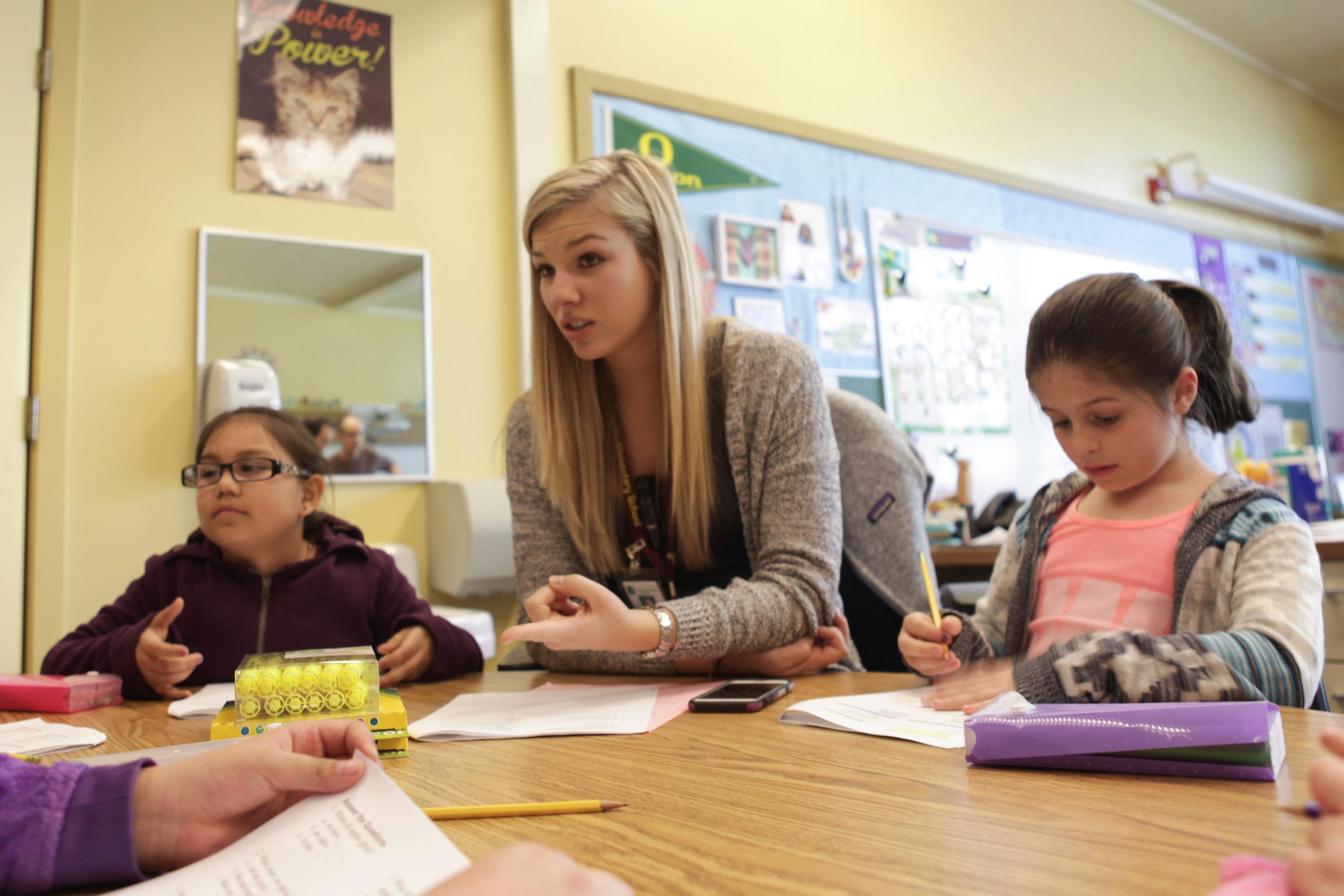
Teacher Michelle Moran, center, helps students with problems during small group work in a late-March class.
Bradley W. Parks / OPB
Oregon earned federal approval Wednesday of its state plan for public schools.
Gov. Kate Brown said the U.S. Department of Education has approved an Oregon plan that "supports a seamless system of education." State Deputy Superintendent Salam Noor called it a "tremendous milestone for Oregon."
When Congress passed the "Every Student Succeeds Act" in late 2015, the idea was to get rid of federal mandates and provide states with more flexibility to run schools. ESSA replaced the No Child Left Behind law, which had been widely criticized for its stringent rules and requirements and out-of-reach achievement targets. By the time the ESSA came to President Obama's desk for his signature, NCLB had become so unpopular that most states had gotten waivers to avoid at least some of the law's rules.
In order to maintain some degree of federal oversight and accountability for states, ESSA required states to submit plans to the U.S. Department of Education for approval. Oregon submitted its final plan in May.
The Department of Education under Secretary Betsy DeVos had drawn criticism earlier this summer for tough vetting of plans submitted by other states. So approval of Oregon's plan comes as a relief to state leaders.
Related: Oregon Will Keep 100 Percent Graduation Goal For Class Of 2025
Oregon’s plan affirmed a state goal that every student complete high school — including 90 percent getting full diplomas — starting in 2025. The plan also aims for having 80 percent of third-graders proficient in reading and math within eight years. Meeting those goals would mean making major improvements.
In addition, Oregon's ESSA plan uses "growth" indicators to measure "academic progress" in the elementary and middle grades. In high school, the plan would also measure "freshmen-on-track," because state officials believe the number of credits a student earns in ninth grade can be a good indicator of whether that student is at high risk of dropping out. The state also included "chronic absenteeism" as a key metric of school quality.
Under the plan, the Oregon Department of Education would measure public schools on up to seven of those indicators. Schools scoring toward the bottom of the state would be identified to receive extra support.
No Child Left Behind prescribed specific steps for schools that fell short of rising benchmarks — including mandated spending on tutoring and allowing students to transfer to higher performing schools. ESSA largely left the remedies for schools that fail to improve up to states.
Oregon's plan makes a point of putting any efforts at school improvement in context of the specific local problems the school may be facing. It offers what it calls "two major shifts Oregon will take to support these schools." One is to analyze schools "as part of a larger district system;" the other is to rely on "local data and local context when determining how to best select and implement additional supports."
Those "shifts" stand in stark contrast to the repeated criticism that NCLB faced as a "one size fits all" federal mandate.
The plan also focuses on the people who spend the most time in Oregon's public schools: teachers and students. The teacher section relies heavily on recommendations published last November by the governor's Council on Educator Advancement. The task force report and ESSA plan focus on better serving Oregon's increasingly diverse student population.
Related: Oregon Schools Get More Time To Meet PE Requirements, Still Face Hurdles
"Oregon needs to recruit, support and retain skilled educators, embracing and embodying a belief that all students can learn," the council report states. "Oregon’s classrooms are becoming more racially, linguistically, culturally, and socioeconomically diverse each year."
Oregon's ESSA plan prioritizes recruiting a more diverse teacher workforce and offering professional development to teachers, so that they're better prepared to teach students from diverse backgrounds.
The new plan also prioritizes aspects of Oregon education that some argue have taken a back seat in recent years such as arts, physical education and the humanities.
State officials said the ESSA plan will not lead to sudden changes at Oregon schools, but "implementation ... will be phased in, starting with the 2017-18 school year."
